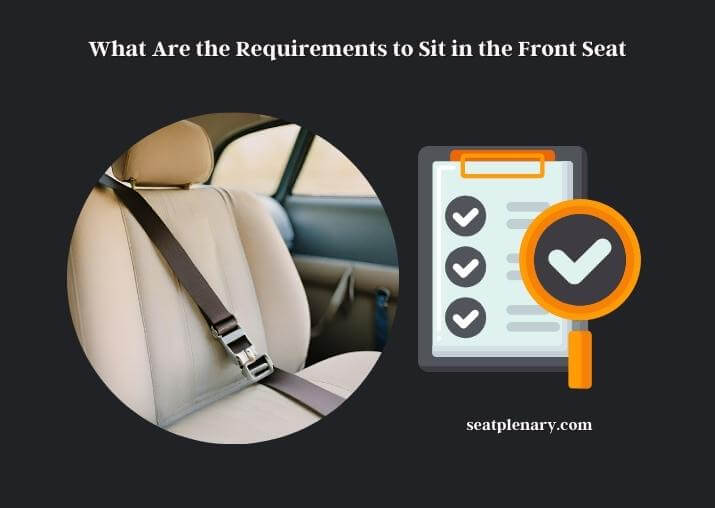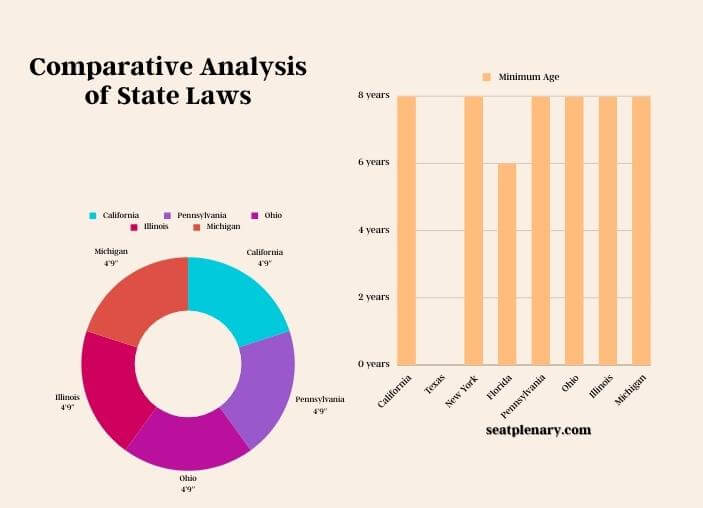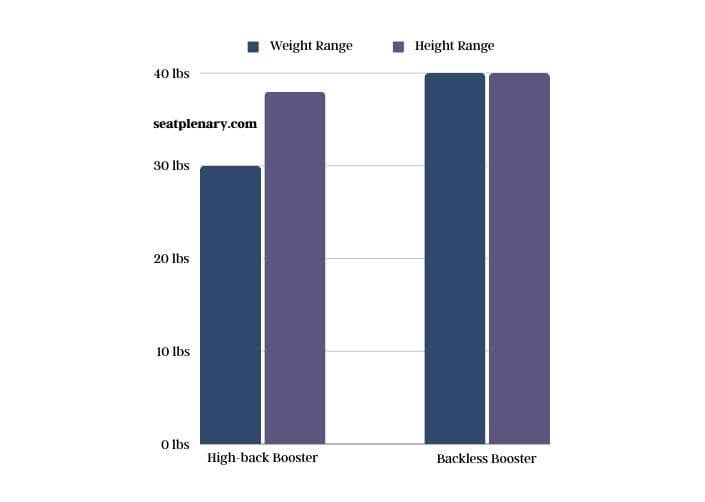The requirements to sit in the front seat of a car vary by state, but generally involve age, height, and weight considerations. It’s essential to follow these guidelines to ensure passenger safety.
Determining the appropriate time for a child to sit in the front seat of a vehicle is a key aspect of car safety. In many regions, children under the age of 13 are advised to sit in the back seat. This recommendation is based on safety concerns, as the front seat poses higher risks due to airbags and the proximity to the windshield.

The question of whether it’s safe for a 10-year-old to ride in the front seat depends on specific state laws and the child’s size. Similarly, queries about the suitability of a 7-year-old or an 11-year-old sitting in the front seat also hinge on these factors. The general advice is to keep children in the back until they are at least 13. However, if a child must sit in the front seat, they should meet the minimum height and weight requirements.
Height and weight play crucial roles in determining front seat safety. While specific numbers can vary, a common guideline is that a child should be at least 4 feet 9 inches tall and weigh over 80-100 pounds to safely sit in the front seat. These requirements ensure that the seat belt fits properly and that the child is adequately protected by the car’s safety features.
For more detailed information on the requirements and safety considerations for children sitting in the front seat, we invite you to read the detailed article below. This will provide a deeper insight into the regulations and best practices for child passenger safety.
Front Seat Requirements – Essential Safety and Legal Guide
Age, Height, and Weight Guidelines for Front Seat
Age Criteria for Front Seat Occupancy
Let’s talk about who gets to ride shotgun! When it comes to kids sitting in the front seat, age is more than just a number; it’s about safety. Most experts agree that children under 13 should stick to the back seat. It’s not just a random age picked out of a hat – it’s based on how their bodies can handle the force of an airbag in the event of a crash. Different states might have their own rules, but the under-13 guideline is a good rule of thumb. Internationally, these age limits can vary, so it’s always best to check the local laws if you’re planning a trip abroad.
Height and Weight Necessities
Now, let’s talk size. It’s not just about being tall enough to ride the rollercoaster; height and weight are key factors in front seat safety. Generally, if a child is at least 4 feet 9 inches tall and weighs between 80 to 100 pounds, they’re in a better position to be protected by the seat belt and airbags. These aren’t just arbitrary numbers; they’re based on how seat belts fit and how airbags deploy. Remember, every child grows differently, so these are guidelines, not hard and fast rules.
State-by-State Legal Framework
Comparative Analysis of State Laws
Navigating state laws can be like trying to solve a puzzle. Each state in the U.S. has its own set of rules about kids in the front seat. To make it a bit easier, here’s a handy table comparing a few states:
| State | Minimum Age | Height Requirement | Weight Requirement |
| California | 8 years | 4’9″ | N/A |
| Texas | N/A | N/A | N/A |
| New York | 8 years | N/A | N/A |
| Florida | 6 years | N/A | N/A |
| Pennsylvania | 8 years | 4’9″ | N/A |
| Ohio | 8 years | 4’9″ | N/A |
| Illinois | 8 years | 4’9″ | N/A |
| Michigan | 8 years | 4’9″ | N/A |

This table shows just how much these regulations can vary. In Texas, there are no specific age, height, or weight requirements, while California has clear guidelines.
Consequences of Not Following Laws
Ignoring these laws isn’t just a slap on the wrist; it can lead to serious consequences. States can impose fines and even points on your driving record for not following child passenger safety laws. It’s not just about avoiding a ticket; it’s about keeping your little ones safe.
Safety Risks and Protective Measures
Hazards of Front Seat Occupancy
Let’s face it, the front seat can be a dangerous place for a kid. The main culprit? Airbags. They’re designed to save adults in a crash, but for a child, the force can be too much. And in a serious accident, being in the front seat can put a child at greater risk of injury. That’s why back seats are the safer bet for the young ones.
Safety Best Practices
So, what can you do to keep your child safe if they have to ride in the front? First, push the seat as far back as possible. This reduces the risk from airbag deployment. Always use the seat belt – no exceptions. And make sure it fits snugly across the chest and lap, not the neck or stomach.
Child Safety Seats to Front Seat Transition
Guidelines for Moving from Booster to Front Seat
Transitioning from a booster seat to the front seat is a big step. It’s not just about age or size; it’s about maturity. Can your child sit still and wear the seat belt properly the entire ride? If yes, they might be ready. But remember, even if they fit the physical requirements, the back seat is still the safest place for them.
Booster Seat Options
Choosing the right booster seat is crucial. Here’s a table to help you out:
| Booster Seat Type | Weight Range | Height Range |
| High-back Booster | 30-100 lbs | 38-57 inches |
| Backless Booster | 40-100 lbs | 40-57 inches |

These are just general guidelines. Always check the booster seat’s manual for specific recommendations.
Exceptions and Special Cases
Medical and Special Needs Accommodations
Sometimes, exceptions need to be made, especially for kids with special medical needs or disabilities. In these cases, it’s essential to consult with a healthcare professional to find the safest way for them to travel.
Influence of Vehicle Design
Not all cars are created equal. In smaller cars, the front seat might be too close to the airbags, making it unsafe for a child. In larger vehicles, the back seat is often the best bet. Always consider your vehicle’s design when deciding where your child should sit.
Technological Developments and Future Directions
Role of Advanced Safety Technologies
Cars are getting smarter, and that’s good news for passenger safety. Features like advanced airbags and smart seat belts adjust to the passenger’s size, making the front seat safer for older children. As these technologies evolve, we might see changes in front seat safety guidelines.
Future of Child Passenger Safety Regulations
As car safety technology advances, so will the laws. We can expect future regulations to take these new technologies into account, potentially making the front seat a safer option for more kids.
FAQs
Does Vehicle Type Affect Front Seat Requirements?
Yes, the type of vehicle can influence front seat requirements. In larger vehicles like SUVs and trucks, the front seat is generally further away from the dashboard and airbags, potentially making it safer for older children. Conversely, in compact cars, the proximity to airbags can be a concern, especially for children under 13. It’s always recommended to consult the vehicle’s owner manual as manufacturers often provide specific guidelines about passenger seating based on the vehicle’s design and safety features.
Are There Exceptions for Short Adults in Front Seat Regulations?
Interestingly, front seat safety isn’t just a concern for children; it also applies to short adults. While there are no specific legal requirements for adults based on height, the same safety principles apply. Short adults, particularly those under 4’9″, should adjust their seat as far back as possible to maintain a safe distance from the airbag. If a vehicle is equipped with adjustable pedal controls and tilt-and-telescoping steering wheels, these should be used to maintain a comfortable and safe driving position.
How Do Airbags Impact Front Seat Safety?
Airbags significantly impact front seat safety. They are designed to deploy in a fraction of a second during a collision to protect adults. However, this rapid deployment can be dangerous for children, particularly if they are seated too close to the airbag or if they are not properly restrained. The force of an airbag can cause serious injuries to children. This is why many safety guidelines recommend that children under 13 sit in the back seat, where they are away from the direct impact zone of front airbags.
What Role Does Child Behavior Play in Front Seat Safety?
Child behavior is a crucial factor in determining front seat safety. It’s not just about size or age; a child’s ability to sit still and properly use the seat belt plays a significant role. Children who can’t sit without fidgeting, who lean forward, play with the seat belt, or put the shoulder belt behind their back or under their arm, are not ready for the front seat. These behaviors can significantly reduce the effectiveness of safety restraints and increase the risk of injury in a crash.
Can Aftermarket Products Modify Front Seat Requirements?
Aftermarket products like seat belt adjusters or cushion boosters are often marketed as solutions for smaller passengers to safely use the front seat.
Caution is advised when using these products. They are not always tested for safety and may interfere with the proper function of the vehicle’s safety systems. It’s best to rely on the vehicle’s built-in adjustments and follow the manufacturer’s guidelines for seat and seat belt usage. Always prioritize products that have been crash-tested and approved for safety.
How Do Front Seat Requirements Change in Different Countries?
Front seat requirements can vary significantly from country to country. For instance, some European countries have stricter rules, often based on height rather than age. In Australia, children under seven are generally not allowed to sit in the front seat. These differences reflect varying approaches to vehicle safety standards and child passenger safety research. When traveling abroad, it’s essential to research and adhere to the local laws regarding front seat occupancy for children.
Is There a Risk in Using Seat Belt Extenders for Children in the Front Seat?
Using seat belt extenders for children in the front seat can be risky. These extenders can alter the way the seat belt fits on the child, potentially reducing its effectiveness in a crash. The seat belt is designed to secure a passenger across the pelvis and shoulder; if an extender causes the belt to fit improperly, it can lead to increased risk of injury. Instead of using extenders, it’s better to ensure the child is of appropriate size and maturity to use the standard seat belt or to keep them in the back seat where they can be safely secured.
So, what have we learned? Age, height, and weight are key factors in deciding when a child can sit in the front seat. State laws vary, so it’s important to know the rules where you live. Safety should always be your top priority, with the back seat being the safest option for kids. And as technology advances, we might see some changes in these guidelines. Remember, keeping your child safe on the road is the most important thing.
